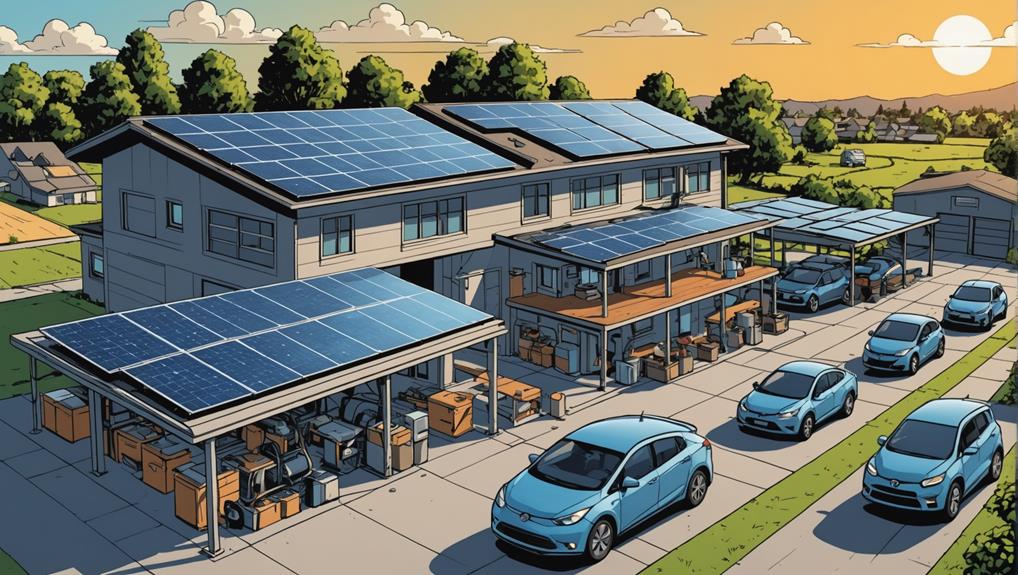Calculating the return on investment time for geothermal energy shows payback periods usually last 5 to 10 years. It depends on factors like climate, energy costs, and system efficiency. With potential yearly savings reaching up to $1,617, geothermal systems prove cost-effective over time. Government incentives, like tax credits, play a role in enhancing the return on investment. Discovering more about geothermal energy ROI can offer valuable insights into financial efficiency and sustainability benefits.
Key Takeaways
- Geothermal energy ROI typically ranges from 5 to 10 years.
- Factors like energy costs and efficiency affect ROI time.
- Tax credits can reduce ROI time to around 14 years.
- Climate impacts ROI, with longer periods in some areas.
- Geothermal systems offer long-term savings and environmental benefits.
Understanding Geothermal System Costs
To comprehend geothermal system costs thoroughly, you must understand the significant expenses involved in installation. Geothermal systems, though energy-efficient, come with higher upfront costs ranging from $20,000 to $30,000, exceeding traditional HVAC systems. A substantial portion of the average $42,000 total cost for a home geothermal system is attributed to ground loop excavations. However, homeowners can benefit from a 30% tax credit on the entire system cost, helping alleviate the initial investment burden.
When considering geothermal systems, weighing the initial investment against the long-term benefits is vital. These systems can lead to significant energy savings, with potential yearly savings of up to $500 on water heating costs and an average of $1,617 in energy savings within the first year. Additionally, maintenance costs are typically reduced by around $500 annually.
Understanding these costs and potential savings is fundamental for evaluating the return on investment and the overall financial viability of geothermal systems.
Calculating Payback Period

Understanding the costs involved in geothermal systems is necessary for evaluating their financial viability, and one key aspect to take into account is the payback period. The payback period for geothermal energy investments typically ranges between 5 to 10 years, influenced by factors such as climate, energy costs, and system efficiency.
In locations like St. Louis, the payback time can extend to around 20 years. However, with the help of federal tax credits, this period can be reduced to approximately 14 years for geothermal HVAC systems.
Your energy consumption habits and usage patterns also play a significant role in determining the payback period. By considering these factors, you can make a more informed decision when assessing the return on investment of geothermal heat pumps.
Keep in mind that the payback period is an important metric to evaluate the financial feasibility of geothermal energy systems.
Additional Factors to Consider

Considering various aspects beyond just the payback period can provide a more thorough assessment of the financial benefits of investing in a geothermal energy system.
Government incentives and tax credits play an essential role in reducing the total cost of installing a geothermal HVAC system, thereby impacting the return on investment.
Investing in a geothermal system not only prioritizes energy efficiency but also contributes to the overall value of your property, potentially increasing home resale value.
Lower maintenance costs associated with geothermal systems over the span of three years can also influence the return on investment time positively.
By utilizing renewable energy sources, geothermal systems offer long-term savings potential, making them a sound financial choice.
Additionally, exploring financing options and seeking HVAC services specialized in geothermal systems can further enhance the benefits and efficiency of your investment, ensuring a quicker return on investment time.
Financing Options for Geothermal Systems

Exploring financing options for geothermal systems can greatly impact the accessibility and affordability of investing in this energy-efficient HVAC solution. When considering financing for geothermal systems, there are several options that can make the investment more feasible for homeowners:
- Monthly payment plans: Many providers offer convenient monthly payment plans specifically tailored for geothermal system installations.
- Flexible financing options: These options can help offset the initial costs associated with installing a geothermal system.
- Affordable solutions: Financing can make high-efficiency geothermal systems more affordable for homeowners looking to upgrade their HVAC systems.
- Financing solutions: Companies like ABE Heating and Cooling provide financing solutions to make geothermal systems more accessible to a wider range of customers, ensuring that the benefits of geothermal energy are within reach for more households.
Geothermal Energy Return on Investment

Geothermal energy's Return on Investment (ROI) serves as an important metric in evaluating the financial efficiency and profitability of geothermal projects. When considering geothermal heating and cooling systems, ROI plays a significant role in determining the savings achieved through high efficiency.
The initial installation costs of geothermal systems can be offset by long-term savings on energy bills, making ROI a key factor for households and businesses looking to reduce their heating or cooling expenses. Additionally, government incentives such as tax credits further enhance the ROI of geothermal projects, making them more financially attractive.
As the world faces the challenges of climate change, the positive ROI of geothermal energy not only contributes to cost-effectiveness but also supports environmental sustainability. Understanding the ROI of geothermal systems is crucial for making informed decisions that benefit both the financial bottom line and the planet's future.
Frequently Asked Questions
What Is the ROI on Geothermal?
When evaluating geothermal projects, understanding the ROI on geothermal energy is key. It calculates profitability by comparing total benefits to costs. Resource quality, development expenses, energy prices, and government policies influence this significant financial metric.
What Is the Eroi for Geothermal Energy?
When exploring geothermal EROI, remember: it's the ratio of net benefits to initial investment. Achieving a positive EROI in geothermal energy is key for evaluating financial viability and ensuring energy sustainability.
How Long Does It Take to Recoup Cost of Geothermal?
To recoup the cost of geothermal, it typically takes 5 to 10 years. In St. Louis, it could be around 20 years, but with tax credits, it drops to about 14 years. Your usage habits and energy rates affect this timeframe.
Is Geothermal Energy Worth Investing In?
Geothermal energy is definitely worth investing in. It offers long-term financial benefits, energy cost savings, and increased home resale value. Consider your usage patterns and energy efficiency to determine the return on investment time.
Which Renewable Energy Source Has a Faster Return on Investment?
When considering return on investment, the wind turbine vs power plant comparison is important. Wind turbines generally have a faster return on investment due to lower construction and maintenance costs. Additionally, wind energy is a renewable resource, making it more cost-effective in the long run compared to traditional power plants.
Conclusion
So, what's the deal with geothermal energy's return on investment time?
Well, understanding the costs, calculating the payback period, and considering additional factors are key.
With various financing options available, the return on investment for geothermal systems can be achieved quicker than you might think.
So, why not make the switch to geothermal and start reaping the benefits sooner rather than later?










